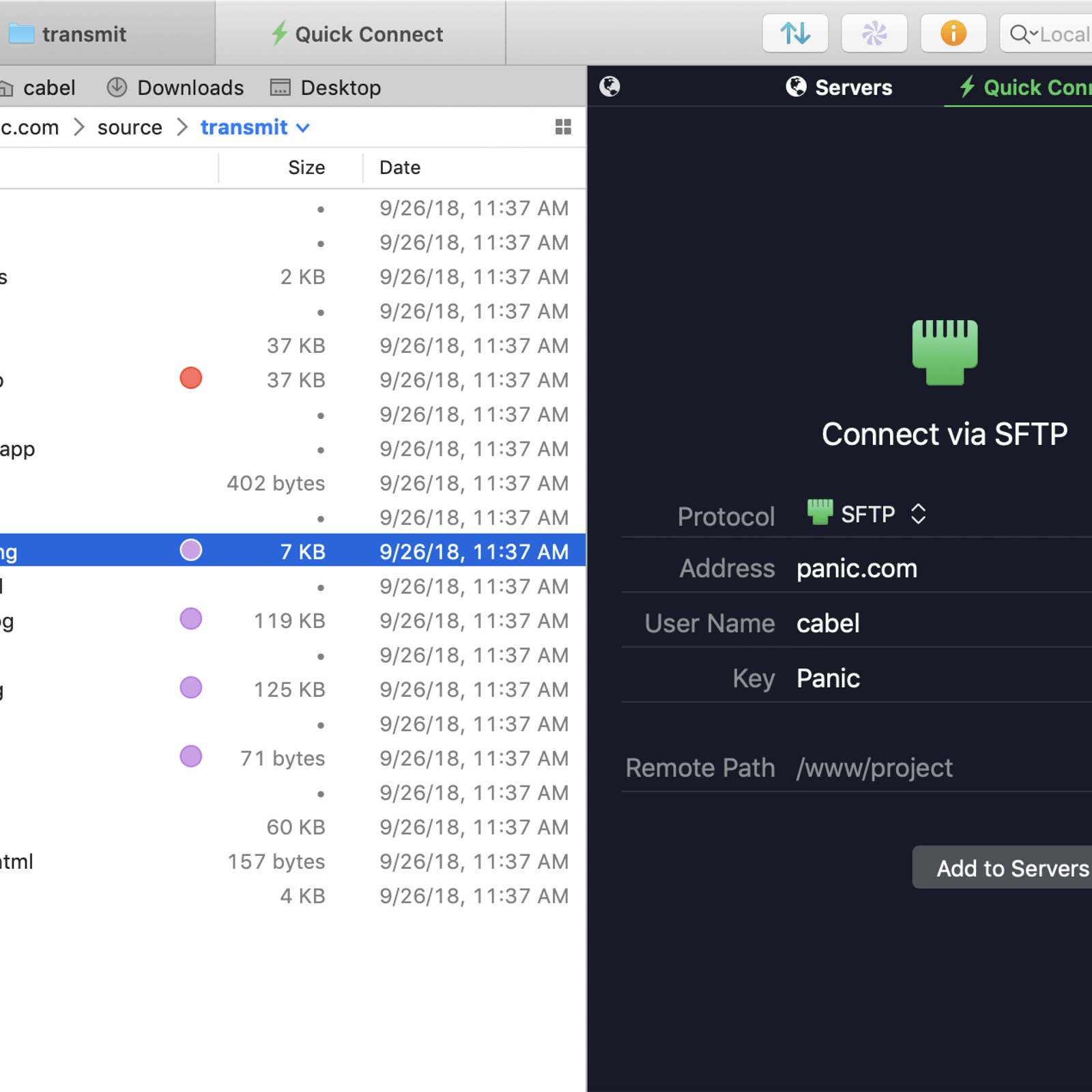Scp For Mac
Name
The SFTP is just not working. Forklift only shows a window with 'Authorized users only' but I am authorised user. Terminal is working only in one direction (from my Mac to the server) and is pain in the ass sometimes. The only soft working for SCP is Interarchy which is 50$ and for that is way to much for few times I need it. WinSCP by Martin Prikryl is one of the most popular, powerful and safe FTP (File Transfer Protocol) clients, but when you start working under Mac OS X, it is no longer a viable solution. If you need an application similar to WinSCP for Mac, you can check this list of alternatives to find a replacement.
scp - secure copy (remote file copy program)
Synopsis
scp [-1246BCpqrv] [-ccipher] [-Fssh_config] [-iidentity_file] [-llimit] [-ossh_option] [-Pport] [-Sprogram] [
Description

scp copies files between hosts on a network. It uses ssh(1) for data transfer, and uses the same authentication and provides the same security asssh(1). Unlike rcp(1), scp will ask for passwords or passphrases if they are needed for authentication.
File names may contain a user and host specification to indicate that the file is to be copied to/from that host. Local file names can be made explicitusing absolute or relative pathnames to avoid scp treating file names containing ':' as host specifiers. Copies between two remote hosts are alsopermitted.

When copying a source file to a target file which already exists, scp will replace the contents of the target file (keeping the inode).
Scp For Mac Os
If the target file does not yet exist, an empty file with the target file name is created, then filled with the source file contents. No attempt is made at'near-atomic' transfer using temporary files.
The options are as follows:
-2' Forces scp to use protocol 2.-4' Forces scp to use IPv4 addresses only.
-6' Forces scp to use IPv6 addresses only.
-B' Selects batch mode (prevents asking for passwords or passphrases).
-C' Compression enable. Passes the -C flag to ssh(1) to enable compression.
-ccipher
Selects the cipher to use for encrypting the data transfer. This option is directly passed to ssh(1).
-Fssh_config
Specifies an alternative per-user configuration file for ssh. This option is directly passed to ssh(1).
-iidentity_file
Selects the file from which the identity (private key) for public key authentication is read. This option is directly passed to ssh(1).
-llimit
Limits the used bandwidth, specified in Kbit/s.
-ossh_option
Can be used to pass options to ssh in the format used in ssh_config(5). This is useful for specifying options for which there is no separate scpcommand-line flag. For full details of the options listed below, and their possible values, see ssh_config(5).
AddressFamily
BatchMode
BindAddress
ChallengeResponseAuthentication
CheckHostIP
Cipher
Ciphers
Compression
CompressionLevel
ConnectionAttempts
ConnectTimeout
ControlMaster
ControlPath
GlobalKnownHostsFile
GSSAPIAuthentication
GSSAPIDelegateCredentials
HashKnownHosts
Host'
HostbasedAuthentication
HostKeyAlgorithms
HostKeyAlias
HostName
IdentityFile
IdentitiesOnly
KbdInteractiveDevices
LogLevel
MACs'
NoHostAuthenticationForLocalhost
NumberOfPasswordPrompts
PasswordAuthentication
Port'
PreferredAuthentications
Protocol
ProxyCommand
PubkeyAuthentication
RekeyLimit
RhostsRSAAuthentication
RSAAuthentication
SendEnv
ServerAliveInterval
ServerAliveCountMax
SmartcardDevice
StrictHostKeyChecking
TCPKeepAlive
UsePrivilegedPort
User'
UserKnownHostsFile
VerifyHostKeyDNS
-Pport
Specifies the port to connect to on the remote host. Note that this option is written with a capital 'P', because -p is already reserved for preservingthe times and modes of the file in rcp(1).
-p' Preserves modification times, access times, and modes from the original file.
-q' Quiet mode: disables the progress meter as well as warning and diagnostic messages from ssh(1).
-r' Recursively copy entire directories. Note that scp follows symbolic links encountered in the tree traversal.
-Sprogram
Name of program to use for the encrypted connection. The program must understand ssh(1) options.
-v' Verbose mode. Causes scp and ssh(1) to print debugging messages about their progress. This is helpful in debugging connection,authentication, and configuration problems.
The scp utility exits 0 on success, and >0 if an error occurs.
Adware for mac. IPV6
IPv6 address can be used everywhere where IPv4 address. In all entries must be the IPv6 address enclosed in square brackets. Note: The square brackets aremetacharacters for the shell and must be escaped in shell.
See Also
rcp(1), sftp(1), ssh(1), ssh-add(1), ssh-agent(1), ssh-keygen(1), ssh_config(5), sshd(8)
History
scp is based on the rcp(1) program in BSD source code from the Regents of the University of California.
Authors
Timo Rinne <tri@iki.fi>
Tatu Ylonen <ylo@cs.hut.fi>
BSD April 14, 2013 BSD
Referenced By
amaddclient(8),cpdup(1),darcs(1),gsissh(1),gsissh_config(5),gsisshd(8),htcp(1),mirrordir(1),openvpn(8),rbldnsd(8),rshdown(1),rssh(1),rssh.conf(5),scponly(8),ztelnetScp For Macbook
(1)Copying files between different linux, MacOSX or UNIX servers can be done with scp command. Mac lipstick for indian skin. Thus you can use scp to transport data between CSC and your local environment or between different file systems at CSC.
The basic syntax for copying data from a local machine to a remote machine is:
And correspondingly the syntax to copy files from a remote machine to a local machine is:
For example user kkayttaj could copy the file data.txt from his/her local computer to his/her home directory in taito.csc.fi server with command:
In the command above, no path or file name is defined in the second argument. This means that the file will be copied to the users home directory with the same name as in the local machine (data.txt). If you would like to use other locations or file name, these values can be defined after the : sign. For example the following command would copy the file data.txt to a directory data_files (a sub directory in the CSC home directory) and name the copied file as data_a2.txt
Mac Scp Client
To copy complete directories you should use scp command with option -r. For example the command below copies a directory data_dir and all its content to Taito. In this case a directory data_dir will be created to directory /wrk/kkayttaj. The content of the data_dir in Taito will be the same as in the local computer including all the subdirectories.
Directory /wrk/kkayttaj is the work directory of user kkayttaj.
Copying the data from CSC environment to local computer is done in the same way. If for example file data.txt locates in the home directory of user kkayttaj it can be copied to the local machine with command:
But if the file locates in the work directory it should be copied with command:
You can check the explicit locations of different directories by first logging in to a server in CSC and then giving command
In the commands above, files and directories have been copied one at a time. However, scp can copy several files at a time:
Mac Scp Gui
You can also use wild cards when defining the files to be copied. For example to copy all files with extension .txt in the current directory to Taito, you could use command
Winscp For Mac Os
By default the copied files are treated as new files, but if you add option -p to the scp command, then the copied file will inherit the date and access mode information from the original file.
Download Scp For Mac
| Previous chapter | One level up | Next chapter |